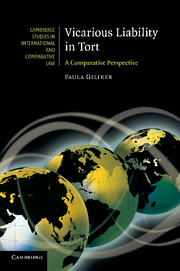Book contents
- Frontmatter
- Contents
- Diagrams
- Table of cases
- Table of legislation
- Preface
- 1 What is vicarious liability?
- 2 Establishing a general framework for liability
- 3 The employer/employee relationship: identifying the contract of employment
- 4 Special difficulties: borrowed employees and temporary workers
- 5 Other relationships giving rise to liability
- 6 Acting in the course of one's employment/functions/assigned tasks: determining the scope of vicarious liability
- 7 Parental liability for the torts of their children: a new form of vicarious liability?
- 8 Understanding vicarious liability: reconciling policy and principle
- 9 A postscript: a harmonised European law of vicarious liability?
- Appendix: Key provisions of the French and German Civil Codes
- Index
- Titles in the series
7 - Parental liability for the torts of their children: a new form of vicarious liability?
Published online by Cambridge University Press: 10 November 2010
- Frontmatter
- Contents
- Diagrams
- Table of cases
- Table of legislation
- Preface
- 1 What is vicarious liability?
- 2 Establishing a general framework for liability
- 3 The employer/employee relationship: identifying the contract of employment
- 4 Special difficulties: borrowed employees and temporary workers
- 5 Other relationships giving rise to liability
- 6 Acting in the course of one's employment/functions/assigned tasks: determining the scope of vicarious liability
- 7 Parental liability for the torts of their children: a new form of vicarious liability?
- 8 Understanding vicarious liability: reconciling policy and principle
- 9 A postscript: a harmonised European law of vicarious liability?
- Appendix: Key provisions of the French and German Civil Codes
- Index
- Titles in the series
Summary
Introduction
In previous chapters, we have examined the operation of vicarious liability across legal systems, focusing, in particular, on its application to the employer/employee context (its most common use). All legal systems have shown an increasing willingness to hold employers strictly liable for the torts of their employees, thereby ensuring that compensation will be paid to third parties, being innocent victims of employee misconduct connected to the workplace.
In most European States, a further head of special liability exists parallel to that discussed above: liability of parents for the harm caused by their children. As Galand-Carval commented, ‘[Parental liability] is sufficiently well established in a majority of European countries for it to appear as a “common European rule”’. The notion of a specific category of parental liability is, however, unknown to the common law which adopts the basic proposition that parents, in common with all defendants, should be subject to the ordinary principles of tort law. Nevertheless, clear analogies may be drawn between the parent/child relationship and the employment context. Employers are expected to exercise a degree of control over their employees. They may give them orders, instruct them how to behave and monitor their performance. Likewise, parents are expected to care for and control their children and are best placed to prevent them from harming others. Further, children are a known risk. They are, by virtue of their age, immature and incapable of fully appreciating the risks of their actions and often irresponsible.
- Type
- Chapter
- Information
- Vicarious Liability in TortA Comparative Perspective, pp. 196 - 226Publisher: Cambridge University PressPrint publication year: 2010



